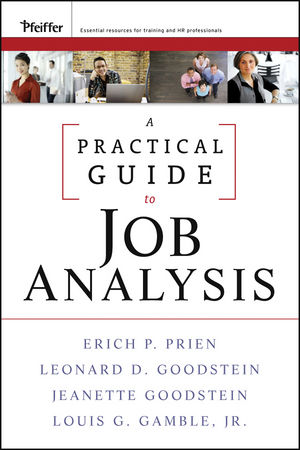唯葶時間
—時間是被栓在心房的一個結—
與其專門抽時間去聽講座參加培訓,還不如定期給自己選上一本好書,今年四月出版的這本新書,或多或少會給你一些啟迪~
Presenting the first book that provides HR professionals with a context for understanding the importance of doing a proper job analysis together with a step-by-step guide to conducting such an analysis. This unique guide contains a series of eight ready-to-use templates that provide the basis for conducting job analyses for eight different levels of job families, from the entry-level to the senior manager/executive.
Chapter 1: Introduction to Job Analysis.
Why Do We Analyze Jobs?
The Hiring Process.
The Human Capital Life Cycle.
Job Analysis.
Recruitment.
Screening.
Final Selection.
Job Orientation.
Training and Development.
Chapter 2: What Is a Job Analysis?
Defining Job Analysis.
Applications of Job Analyses.
Recruitment.
Candidate Selection.
Employee Training and Development.
Performance Management.
Organizational Management and Planning.
Litigation Protection.
Elements of a Job Analysis.
Work Activity (WA).
Knowledge, Skills, and Ability (KSA).
Levels of Job Performance.
Workplace Characteristics.
Chapter 3: How to Conduct a Job Analysis.
Methods of Job Analysis.
Self-Reports.
Direct Observations.
Interviews.
Document Reviews.
Questionnaires and Surveys.
Caveats and Cautions.
Changes Over Time.
Low Accuracy.
Lack of Stability.
Chapter 4: The Job Analysis Templates.
The Development of the Templates.
Eight Templates for Job Analysis.
Entry-Level Job Analysis Template (Appendix B).
Production Operations Job Analysis Template (Appendix C).
Clerical Job Analysis Template (Appendix D).
Sales and Sales Management Job Analysis Template (Appendix E).
Technical and Professional Services Job Analysis Template (Appendix F).
Professional Administrative Job Analysis Template (Appendix G).
Supervisory/First-Line Manager Job Analysis Template (Appendix H).
Senior Management/Executive Job Analysis Template (Appendix I).
Using the Templates.
Completing the Summary Forms.
Chapter 5: The Workplace Characteristics Profile.
Organization Culture and Climate.
Organization Culture.
Organization Climate.
The Workplace Characteristics Profile.
Developing the WCP.
Administering the WCP.
Interpreting the WCP.
Chapter 6: Establishing Job Performance Levels.
Competencies and Jobs.
The Uses of Job Performance Data.
Recruitment.
Creating Career Ladders.
Evaluating Organizational Performance.
Improving Organizational Performance.
Methods for Measuring Job Performance.
Objective Measures.
Subjective Measures.
Problems with Performance Ratings.
Behaviorally Anchored Ratings Scales (BARS).
How to Implement the BARS Method.
A Recommended Shortcut.
Applying the BARS Method.
BARS and the Hierarchy of Jobs.
Concerns About BARS.
A Summary of the Job Analysis Process.
Authors Info:
Erich P. Prien, Ph.D., is an industrial/organizational psychologist specializing in the development, standardization, and application of psychological tests. He is the founder and president of Performance Management Press.
Leonard D. Goodstein, Ph.D., is a consulting psychologist specializing personality assessment. He is a principal with Professional Assessment Service and Solutions.
Jeanette Goodstein, Ph.D., is an organizational consultant and writer specializing in working with governmental and non-profit organizations. She is the co-author of the award-winning Who's Driving Your Bus and Applied Strategic Planning: The Consultant's Tool Kit.
Louis G. Gamble, Jr., Ed. D., is a consultant and entrepreneur specializing in the application of information technology to organizational change. He is a principal with Inclusive Marketing Consultants, LLC.





大致略讀了一遍,還沒有理好精髓,等做好了Note再和你分享
有一點點失望,量化鑒定表的篇幅占得太大了些,其實俺關心的是整體的概念倡導而不是細節。